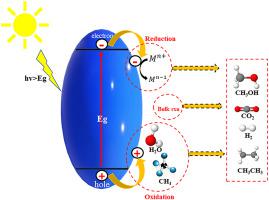Renewable and Sustainable Energy Reviews ( IF 16.3 ) Pub Date : 2020-07-06 , DOI: 10.1016/j.rser.2020.110024 Mohanned Mohamedali , Olumide Ayodele , Hussameldin Ibrahim

|
The conversion of methane to fuel and value-added chemicals such as syngas and oxygenated hydrocarbons is an attractive proposition for the energy and chemical industry. The conventional technologies for methane conversion are energy-intensive, costly, and major sources of greenhouse gas emissions. Low-temperature direct methane valorization is an attractive energy solution to significantly reduce dependency on current commercial technologies. Amongst the wide portfolio of the direct methane conversion processes is the photocatalytic liquefaction of methane to oxygenated hydrocarbons, which utilizes solar radiation to stimulate methane activation for methanol production. The low activity, selectivity, and low efficiency of the photocatalytic route, compared to other well-established technologies for the conversion of methane, limited their wide-scale applications. Therefore, a review of the existing literature is required to give a perspective of this promising technology, to discuss challenges and to identify potential areas for research and development and ultimately contribute to promoting green methane conversion processes. This review aims to highlight the state-of-the-art and the progress achieved in the catalyst development studies of the photocatalytic conversion of methane to oxygenated hydrocarbons. A special focus is given to WO3, bismuth-based, and zeolite photocatalysts used in the direct photocatalytic conversion of methane under moderate conditions. The catalyst structure-property relationship, the effect of operating conditions on reactivity, and reaction mechanism studies are discussed to highlight the challenges and opportunities for future research work. A perspective and outlook of the direct methane liquefaction technology are presented which emphasize the potential areas for improvements of catalytic activity and selectivity.
中文翻译:

甲烷光催化液化为含氧烃的挑战与前景
甲烷向燃料和增值化学品(例如合成气和氧化烃)的转化对于能源和化工行业来说是一个有吸引力的提议。甲烷转化的常规技术耗能大,成本高且是温室气体排放的主要来源。低温直接甲烷平衡技术是一种有吸引力的能源解决方案,可大大减少对当前商业技术的依赖。在直接甲烷转化过程的广泛产品中,甲烷是光催化液化为含氧烃,它利用太阳辐射来刺激甲烷活化以生产甲醇。与其他成熟的甲烷转化技术相比,光催化路线的活性低,选择性高且效率低。限制了它们的大规模应用。因此,需要对现有文献进行回顾,以便对该技术有前景的观点,讨论挑战并确定潜在的研究和开发领域,并最终为促进绿色甲烷转化工艺做出贡献。这篇综述的目的是强调甲烷的光催化转化为含氧烃的催化剂开发研究的最新技术和进展。特别关注WO 这篇综述的目的是强调甲烷的光催化转化为含氧烃的最新技术和在催化剂开发研究中取得的进展。特别关注WO 这篇综述的目的是强调甲烷的光催化转化为含氧烃的最新技术和在催化剂开发研究中取得的进展。特别关注WO3,在中等条件下用于甲烷的直接光催化转化的铋基和沸石光催化剂。讨论了催化剂的结构-性质关系,操作条件对反应性的影响以及反应机理的研究,以突出未来研究工作的挑战和机遇。介绍了直接甲烷液化技术的观点和前景,强调了改进催化活性和选择性的潜在领域。











































 京公网安备 11010802027423号
京公网安备 11010802027423号